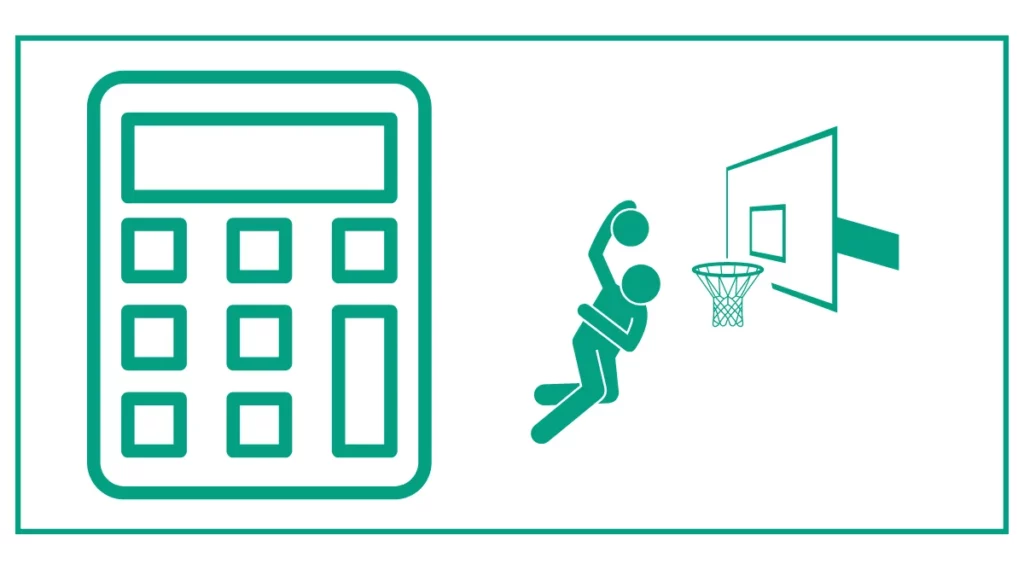Dunk Calculator
Are you a basketball player?
Are you a die-hard fan of basketball?
Do you want to calculate your or your favorite player’s dunk statistics?
This dunk calculator helps you calculate all the essential parameters related to the slam dunk or the basketball dunk.
These parameters include the jump height to dunk a basketball, vertical jump to touch the rim, vertical jump to do 360° windmill, hang time, effective hang time, speed of the dunk, and take-off velocity.
In case you don’t know, a dunk is a basketball shot in which a player jumps in the air, controls the ball above the rim, and scores by ramming the ball directly through the basket with one or both hands.

You might want to calculate your EGF or determine the game score.
Understanding the Dunk Calculator
The dunk calculator is a user-friendly tool designed to help basketball enthusiasts and aspiring dunkers evaluate their jumping ability and determine how high they need to jump to successfully dunk a basketball. By inputting a few key measurements, you can get an accurate estimate of your vertical jump requirements and assess your potential for performing various types of dunks.
How the Dunk Calculator Works?
To use the dunk calculator, you’ll need to input three essential measurements:
- Height of the rim
- Your standing reach
- Extra reach when dunking
The calculator uses these inputs to determine:
- The vertical jump height needed to dunk
- Your current vertical jump (if you can touch the rim)
- The jump height required for more advanced dunks
By providing this information, the dunk calculator helps you understand your current capabilities and what you need to work on to achieve your dunking goals.
The Importance of Vertical Jump in Basketball
Vertical jump is a crucial aspect of basketball performance, particularly when it comes to dunking. A player’s vertical leap directly impacts their ability to reach the rim, block shots, and grab rebounds. While not everyone needs to dunk to be successful in basketball, a strong vertical jump can significantly enhance a player’s overall game.
Factors Affecting Vertical Jump
Several factors contribute to an individual’s vertical jump height:
- Muscle strength, particularly in the legs and core
- Explosiveness and power generation
- Flexibility and range of motion
- Technique and form
- Body composition and overall fitness
Understanding these factors can help you focus your training efforts to improve your vertical jump and increase your chances of successfully dunking a basketball.
How to Measure Your Standing Reach
Before using the dunk calculator, you’ll need to accurately measure your standing reach. This measurement is crucial for determining how high you need to jump to dunk. Here’s how to measure your standing reach:
- Stand facing a wall with your feet flat on the ground.
- Reach up as high as you can with both arms extended.
- Mark the highest point you can reach on the wall.
- Measure the distance from the floor to the mark.
This measurement represents your standing reach, which is a key input for the dunk calculator.
Calculating Your Vertical Jump
To calculate your current vertical jump, you’ll need to perform a simple test:
- Stand next to a wall or use a vertical jump measuring device.
- Jump as high as you can and touch the wall at your maximum height.
- Measure the distance between your standing reach and the highest point you touched.
The difference between these two measurements is your vertical jump height. This information can be useful when comparing your current abilities to the requirements for dunking.
Using the Dunk Calculator to Assess Your Dunking Potential
Now that you have your measurements, it’s time to use the dunk calculator to determine your dunking potential. Input your standing reach, the height of the rim (typically 10 feet or 305 cm for a regulation basketball hoop), and your estimated extra reach when dunking.
The calculator will provide you with the following information:
- The vertical jump height needed to dunk a basketball
- Your current vertical jump (if you can touch the rim)
- The jump height required for more advanced dunks, such as a 360° windmill
By comparing these results to your current vertical jump, you can assess how close you are to achieving your dunking goals and what improvements you need to make.
Interpreting the Results
After using the dunk calculator, you’ll have a clear idea of where you stand in terms of dunking ability. Here’s how to interpret the results:
- If your current vertical jump exceeds the required height for dunking, congratulations! You likely have the physical ability to dunk a basketball.
- If your vertical jump falls short of the required height, don’t be discouraged. The calculator provides a target for you to work towards in your training.
- Pay attention to the jump heights required for more advanced dunks. These can serve as long-term goals as you improve your vertical leap.
Remember, the dunk calculator provides an estimate based on your inputs. Factors such as technique, timing, and hand size can also influence your ability to dunk successfully.
Improving Your Vertical Jump
If the dunk calculator reveals that you need to increase your vertical jump to achieve your dunking goals, don’t worry. There are several strategies you can employ to improve your leaping ability:
Strength Training
Focus on exercises that target the muscles used in jumping:
- Squats
- Deadlifts
- Lunges
- Calf raises
These exercises build the strength needed for explosive jumps.
Plyometrics
Incorporate plyometric exercises to improve your power and explosiveness:
- Box jumps
- Depth jumps
- Burpees
- Jump squats
Plyometrics help train your muscles to generate force quickly, which is essential for a high vertical jump.
Flexibility and Mobility
Improve your range of motion with stretching and mobility exercises:
- Dynamic stretching before workouts
- Static stretching after workouts
- Yoga or Pilates for overall flexibility
Greater flexibility can contribute to a more powerful jump and reduce the risk of injury.
Technique and Form
Work on your jumping technique:
- Practice proper arm swing
- Focus on explosive hip extension
- Land softly to protect your joints
Proper form can help you maximize your jumping potential and minimize the risk of injury.
Benefits of a Strong Vertical Jump
While dunking is an exciting goal, the benefits of improving your vertical jump extend far beyond the ability to slam the ball. A strong vertical leap can enhance various aspects of your basketball game and overall athletic performance:
- Rebounding: A higher jump gives you an advantage in grabbing rebounds on both ends of the court.
- Shot blocking: Improved jumping ability allows you to contest and block more shots.
- Finishing at the rim: Even if you can’t dunk, a better vertical jump helps you finish layups and close-range shots over defenders.
- Overall athleticism: The explosiveness developed through vertical jump training can improve your speed, agility, and overall athletic performance in various sports.





